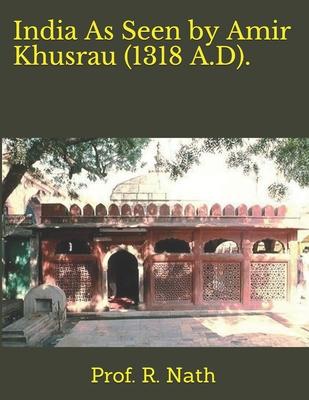India As Seen by Amir Khusrau (1318 A.D).

India As Seen by Amir Khusrau (1318 A.D).
This is English translation of the Third Chapter (Sipihr) of Amir Khusrau's Persian Mathnawi, the Nuh-Sipihr(also known as the Sultan-Namah) which is the most important and the most famous of his works. It was written in the year A.H. 718/1318 A.D. at the instance of the ruling Khalji Sultan Qutbu'd-Din Mubarak Shah, to whom it is dedicated. The Nuh-Sipihr was composed when Khusrau was 65, and a matured and accomplished poet, and this work is, undoubtedly, an excellent piece of Persian literature. Though designed to record, in the spirit of history. The principal events of the reign of Mubarak Shah, upon whom he showers extra-lavish eulogies, the Nuh-Sipihr is more important for its description of India and its people, their knowledge and learning, arts and sciences, its fauna and flora, and almost all good points which make India the Paradise on earth. Khusrau was patriot to the core and his personality is most brilliantly reflected in this work. He sings a thousand songs in praise of his motherland (watan) and exerts his wits to prove India's superiority to all other countries of the world.The Nuh-Sipihr is divided into nine chapters, each dedicated to a sky; thus the first chapter is dedicated to the Ninth and the highest sky, the second to the Eighth, third to the Seventh, and so on, in a descending order. Hence, the title of the work: Nuh-Sipihr (Nine Skies). Title of each chapter is given in a beautiful couplet; thus there are nine chapter- couplets. Sub-headings have also been given in each chapter, each sub-heading also being a couplet. In all, there are 52 topics in the Nuh-Sipihr. The figure 52 is considered auspicious in India and the distribution of the work into 52 headings is symbolic. It is the third Chapter which mostly deals with India and the things Indian and, by far, this is the most important chapter of this composition. The present work is, essentially, a translation of this chapter. The Persian text of the Nuh-Sipihr edited by Muhammad Wahid Mirza (OUP Calcutta 1950) has been used for this translation. It has been referred to, hereinafter, in this work, as NS. It excludes the last two sub-headings of the Third Chapter which are related to the military campaigns of Deogiri and Telingana. Thus, it is translation of the NS pp. 147-195 (49 pages). Besides, 14 couplets of the Ninth Chapter (Topic No.51 NS, pp.442-43) have also been translated here under chapter-VIII. Important material, not covered by the main text (NS, 147-195) which
PRP: 116.25 Lei
Acesta este Pretul Recomandat de Producator. Pretul de vanzare al produsului este afisat mai jos.
104.62Lei
104.62Lei
116.25 LeiLivrare in 2-4 saptamani
Descrierea produsului
This is English translation of the Third Chapter (Sipihr) of Amir Khusrau's Persian Mathnawi, the Nuh-Sipihr(also known as the Sultan-Namah) which is the most important and the most famous of his works. It was written in the year A.H. 718/1318 A.D. at the instance of the ruling Khalji Sultan Qutbu'd-Din Mubarak Shah, to whom it is dedicated. The Nuh-Sipihr was composed when Khusrau was 65, and a matured and accomplished poet, and this work is, undoubtedly, an excellent piece of Persian literature. Though designed to record, in the spirit of history. The principal events of the reign of Mubarak Shah, upon whom he showers extra-lavish eulogies, the Nuh-Sipihr is more important for its description of India and its people, their knowledge and learning, arts and sciences, its fauna and flora, and almost all good points which make India the Paradise on earth. Khusrau was patriot to the core and his personality is most brilliantly reflected in this work. He sings a thousand songs in praise of his motherland (watan) and exerts his wits to prove India's superiority to all other countries of the world.The Nuh-Sipihr is divided into nine chapters, each dedicated to a sky; thus the first chapter is dedicated to the Ninth and the highest sky, the second to the Eighth, third to the Seventh, and so on, in a descending order. Hence, the title of the work: Nuh-Sipihr (Nine Skies). Title of each chapter is given in a beautiful couplet; thus there are nine chapter- couplets. Sub-headings have also been given in each chapter, each sub-heading also being a couplet. In all, there are 52 topics in the Nuh-Sipihr. The figure 52 is considered auspicious in India and the distribution of the work into 52 headings is symbolic. It is the third Chapter which mostly deals with India and the things Indian and, by far, this is the most important chapter of this composition. The present work is, essentially, a translation of this chapter. The Persian text of the Nuh-Sipihr edited by Muhammad Wahid Mirza (OUP Calcutta 1950) has been used for this translation. It has been referred to, hereinafter, in this work, as NS. It excludes the last two sub-headings of the Third Chapter which are related to the military campaigns of Deogiri and Telingana. Thus, it is translation of the NS pp. 147-195 (49 pages). Besides, 14 couplets of the Ninth Chapter (Topic No.51 NS, pp.442-43) have also been translated here under chapter-VIII. Important material, not covered by the main text (NS, 147-195) which
Detaliile produsului









